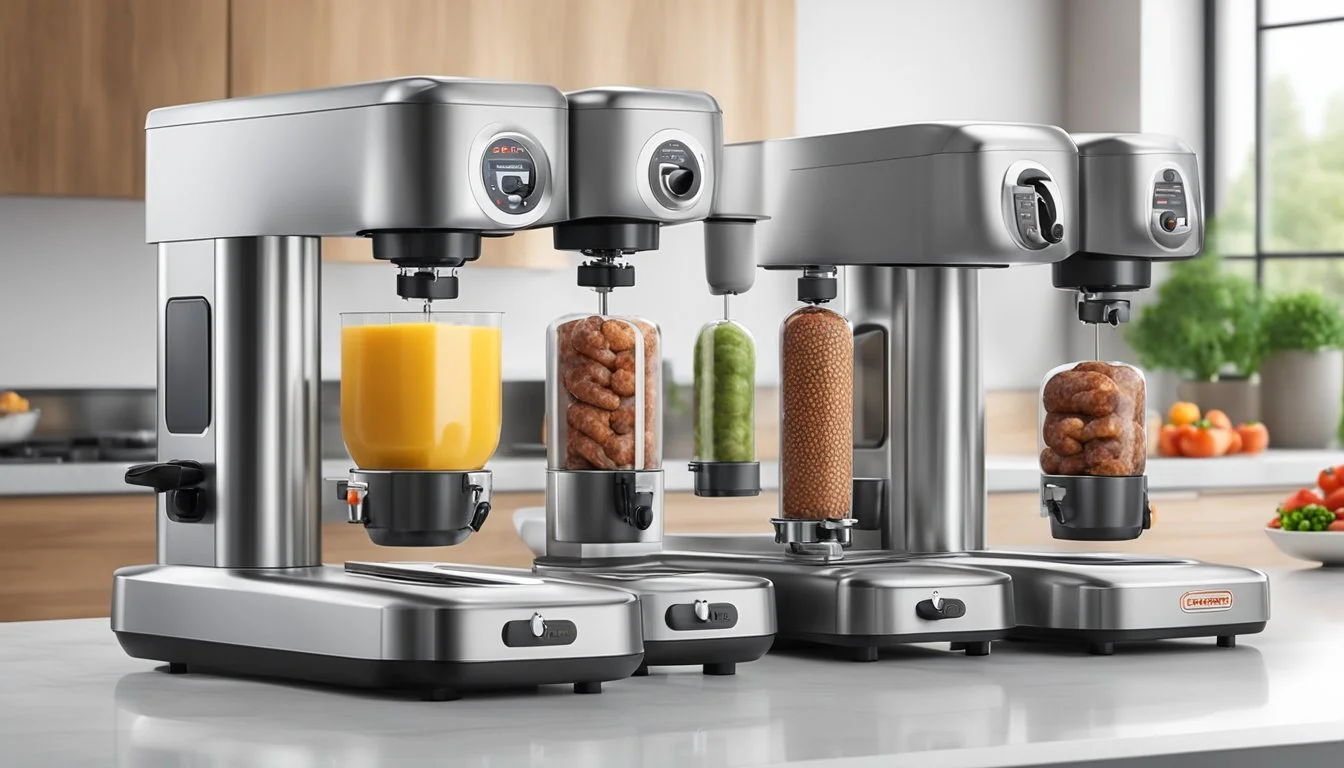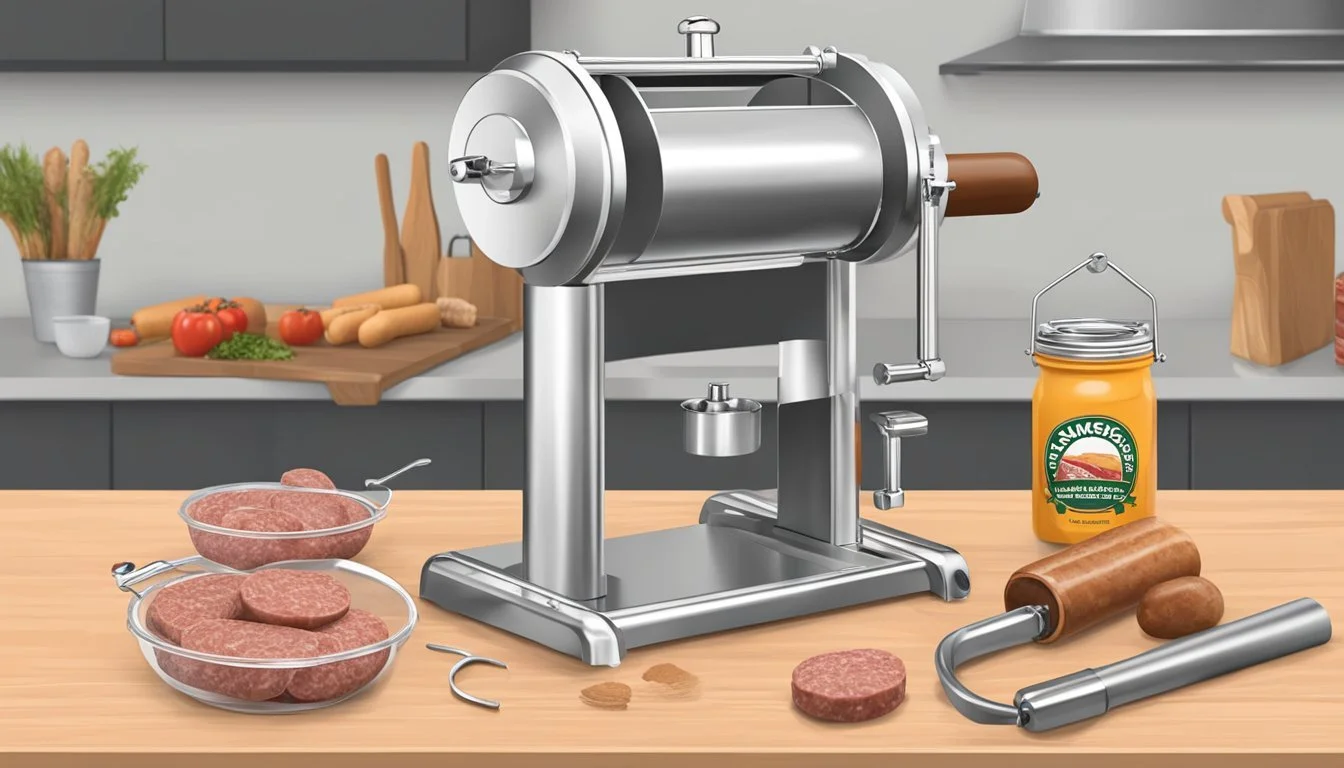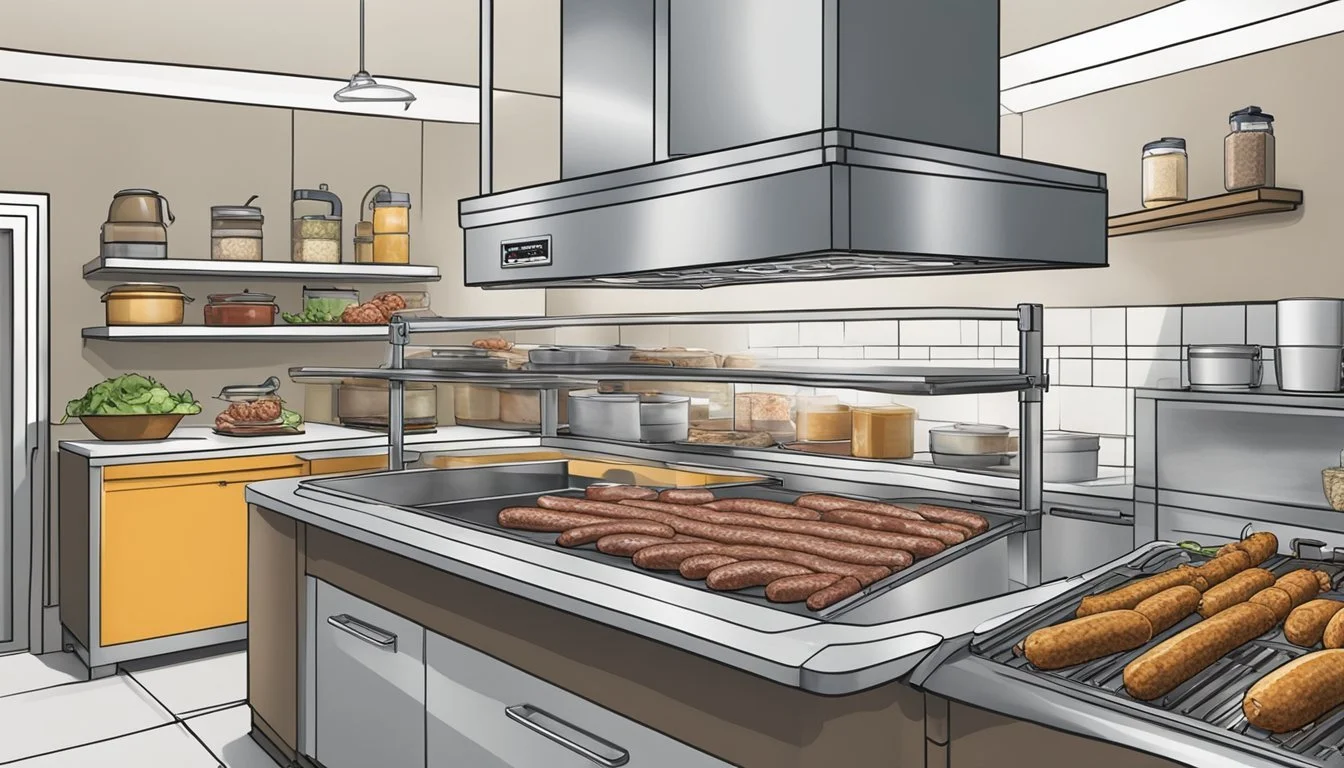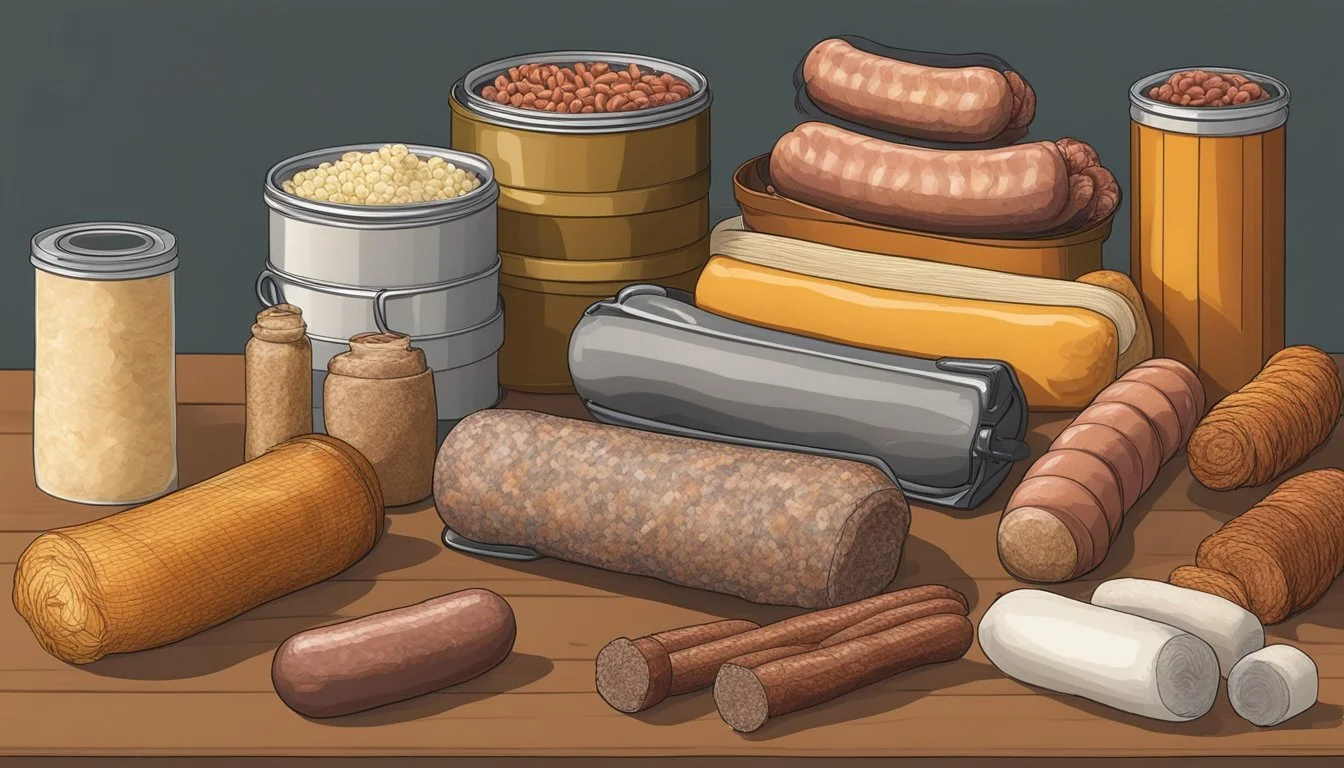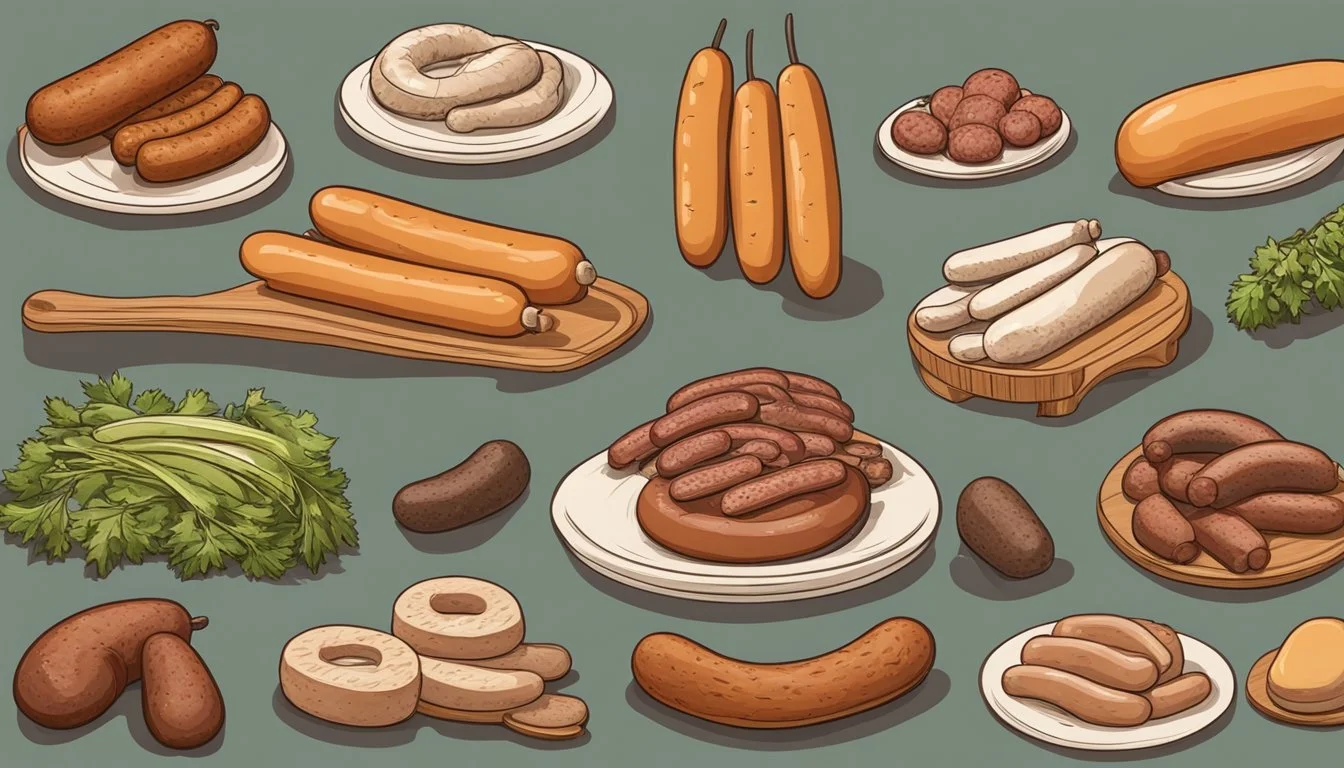The Ultimate Guide to Choosing the Best Sausage Stuffer
Key Factors for Home Cooks
Making homemade sausage is a craft that combines culinary skills with the right tools for the task. Choosing the best sausage stuffer is essential for efficient and satisfying sausage production. A sausage stuffer is designed to simplify the process of filling casings with ground meat and spices. This tool ensures that the casings are filled evenly and to the desired thickness, making the difference between professional-looking sausages and amateur attempts.
With various models available in the market, including electric and manual options, potential buyers must consider factors such as construction quality, capacity, ease of use, and durability when selecting a sausage stuffer. Some kitchen enthusiasts may prefer a simple, no-frills manual stuffer for the occasional batch, while others might invest in a motorized version to handle larger quantities with ease. As homemade sausage making grows in popularity, understanding the nuances of each sausage stuffer becomes increasingly important.
In reviewing the latest offerings, it's evident that products range from budget-friendly devices suitable for beginners, to high-end equipment designed for seasoned sausage makers. A stuffer that offers the best value doesn't necessarily have to be the most expensive, but rather one that aligns with the user's needs and expectations. By focusing on the specifics of construction materials, functionality, and additional features like speed adjustments or attachments, individuals can find the stuffer that will serve them best.
Understanding the Basics of Sausage Stuffers
When embarking on homemade sausage production, selecting a suitable sausage stuffer is a critical decision. Sausage stuffers come in various forms, including manual and electric models. The choice between these types depends largely on the user's volume of sausage production, efficiency needs, and personal preference.
Manual sausage stuffers operate with a hand crank, giving the user total control over the speed and consistency of the stuffing process. They are typically preferred for small to moderate batches and are revered for their simplicity and reliability.
Manual Stuffers
Hand-operated
Pros: Full user control, Simple to use, Usually more affordable
Cons: Labor-intensive, Slower than electric models, Minimal maintenanceOn the other hand, an electric sausage stuffer is equipped with a motor, which automates the stuffing process. These are ideal for users producing sausage in larger quantities who prioritize convenience and speed.
Electric Stuffers: Faster, less manual effort, consistent production.
Ideal for: High volume, efficiency-driven operations.
One cannot discuss sausage stuffers without mentioning prominent brands like Hakka Sausage Stuffer which is often noted for its balance of quality and practicality. Hakka's sturdy construction and user-friendly design make it a go-to option for both novices and seasoned sausage makers.
In choosing between these units, it is prudent to weigh factors like capacity, durability, and ease of cleaning. High-quality stuffers typically feature stainless steel parts, convenient attachments for different sausage sizes, and a design that simplifies the disassembly and cleaning process. The decision to invest in a manual or electric model should align with the user's production scale, time constraints, and quality considerations.
Types of Sausage Stuffers
When selecting the right sausage stuffer for homemade sausage production, it's important to understand the different types available. Each type offers unique features suited to different preferences and production scales.
Manual Sausage Stuffers
Manual sausage stuffers require physical effort to operate, but they offer control over the sausage-making process. Hakka Brothers and LEM produce some popular manual stuffers, available in both horizontal and vertical configurations. Vertical manual stuffers, such as the LEM 5-Pound Stainless Steel Vertical Sausage Stuffer, typically feature a plunger that is pushed down to extrude the meat through a tube.
Electric Sausage Stuffers
Electric sausage stuffers automate the stuffing process, reducing manual labor and increasing efficiency. Options like the Weston 33-1301-W stand out for capacity and power, capable of grinding and stuffing with minimal user effort. They are ideal for those who produce large volumes of sausage.
Horizontal and Vertical Sausage Stuffers
Sausage stuffers come in two orientations: horizontal and vertical. Horizontal stuffers, like the Master Feng Sausage Stuffer, sit parallel to the work surface, while vertical stuffers stand perpendicular. The Hakka Brothers 7 LB/3L Sausage Stuffer is an example of a vertical stuffer, which often takes up less countertop space and can leverage gravity in the stuffing process.
Horn Sausage Stuffers
Horn sausage stuffers are the most traditional type, named for their horn-like shape. These are typically manual and clamped to a table edge for stability. Horn stuffers are best suited for small-scale use and those new to sausage making. They are simple, affordable, and perfect for infrequent use.
Key Features to Consider
When choosing the best sausage stuffer for homemade sausage production, one must consider several key features that affect performance, durability, and ease of use.
Capacity and Size
Capacity, often measured in pounds or liters, determines how much meat a sausage stuffer can hold, impacting the overall productivity. Sizes vary, typically ranging from 5 to 30 pounds. Selecting the right capacity ensures a balance between efficiency and the space available in the kitchen.
Material and Construction
The material of a sausage stuffer is crucial, with stainless steel construction being highly sought after for its durability and corrosion resistance. Other materials may include die-cast aluminum; however, they may not offer the same longevity as stainless steel.
Ease of Cleaning and Maintenance
An easy-to-clean sausage stuffer saves time and maintains hygiene. Look for models with detachable components that can be easily taken apart and cleaned. Find units that require minimal maintenance to ensure a hassle-free sausage making process.
Stuffing Tubes and Nozzles
Stuffing tubes and nozzles dictate the size and shape of sausage casings that can be filled. It's important to choose a stuffer that comes with a variety of nozzle sizes, allowing for flexibility in sausage production, from thin breakfast links to thicker sausages.
Speed and Efficiency
A sausage stuffer's speed impacts production time. Manual stuffers give more control, while electric units offer faster operation. Consider if a higher speed aligns with the required level of efficiency in the user's sausage making processes.
Durability and Quality
Durability reflects the lifespan of the sausage stuffer. Quality units boast solid metal gears and heavy-duty construction, often reflected in the manufacturer’s warranty. These features contribute to the sturdiness and long-term reliability of the equipment.
The Importance of Sausage Casing Selection
Choosing the right sausage casings can significantly impact the quality, texture, and flavor of homemade sausages. This section explores the differences between natural and collagen casings, as well as considerations for casing diameter and length.
Natural versus Collagen Casings
Natural Casings: Made from animal intestines, natural casings are favored for their ability to provide a distinctive "snap" when bitten into. They should be soaked in water before use to ensure flexibility, which allows for easier stuffing and reduces the risk of tearing.
Pros:
Offers a traditional appearance and texture
Biodegradable and can be twisted into links without separation
Cons:
Variable diameter and length, which can lead to inconsistent sausage sizes
Requires refrigeration and careful handling
Collagen Casings: These casings are derived from collagen in animal hides. They offer uniformity in size and are generally easier to handle. Collagen casings typically do not require soaking and are ready to use out of the package.
Pros:
Consistent diameter and length for even sausage production
No preparation needed before stuffing
Cons:
Lacks the distinctive "snap" of natural casings
Not as durable when twisted, possibly requiring metal clips to seal
Casing Diameter and Length
Diameter: The diameter of the casing affects both the size of the sausage and the cooking time. Typically, casings range between 16mm (snack-size sausages) and 32mm (standard bratwurst or Italian sausage). It's essential to select a diameter that suits the intended sausage style.
Length: Length choice depends on the volume of sausage one plans to produce. Most commercial casings come in "hanks" or pre-cut lengths. For instance, hog casings might come in lengths that can hold from 1 1/2 to 3 lbs of meat per casing.
When selecting casings, manufacturers should consider the following:
The type of sausage they wish to produce (e.g., traditional bratwurst, breakfast links)
The expected final product appearance
The volume of meat that will be stuffed at a time
By carefully selecting casings based on these key factors, one can achieve the desired outcomes for homemade sausage production.
Enhancing Flavor: Spices and Ingredients
When crafting homemade sausage, the selection of spices and ingredients is pivotal to enhancing the overall flavor. One begins with fresh, high-quality meat as the canvas for a tapestry of taste but it is the spices and additional ingredients that truly create a masterpiece.
Salt: The foundation for flavor; it draws out the meat’s natural taste.
Black Pepper: Adds a sharp, pungent kick.
Paprika: Imparts warmth and color, with variants ranging from sweet to hot.
Garlic Powder: Provides a robust, earthy base.
Fresh Ingredients: For depth and brightness in sausage, chefs often incorporate:
Fresh Garlic: Enhanced piquancy compared to its powdered form.
Fresh Herbs: Think rosemary, thyme, or sage for woodsy notes.
Expert Tip: Balancing spices is crucial; too little and the sausage is bland, too much and it's overwhelming. Employ a light hand and taste as one progresses.
Pork: Fennel, sage, and onion powder complement its natural richness.
Beef: Bold spices like coriander and cayenne pepper match well.
Chicken: Delicate herbs and lemon zest accentuate the mildness.
Incorporation Method: Equal distribution of spices is key. Mix them thoroughly into the ground meat before funneling into the stuffer. This uniformity ensures that each bite is seasoned to perfection. By meticulously choosing spices and ingredients, one turns basic ground meat into gourmet sausages bursting with flavor.
Maintenance and Hygiene Standards
When it comes to sausage stuffers, maintaining high levels of cleanliness and adhering to stringent hygiene standards are crucial for safe food production. Effective cleaning practices, proper storage and handling, and a rigorous approach to hygiene in sausage production are all essential to prevent food contamination.
Cleaning Practices
To ensure food safety, one should thoroughly clean their sausage stuffer after each use. Begin by disassembling the stuffer to reach all surfaces that come into contact with food. Use hot soapy water and a mild detergent to scrub all components, followed by a rinse with clean water to remove any soap residue. For optimal hygiene, sanitize with a solution approved for food contact surfaces, and dry all parts completely to prevent bacterial growth.
Storage and Handling
Proper storage and handling are essential to maintain a sausage stuffer's longevity and hygiene. Store all components in a clean, dry place to thwart the development of mold or bacteria. It's recommended to keep the device covered to protect it from airborne contaminants. Additionally, one should always handle the stuffer with clean hands and utensils to prevent the introduction of pathogens.
Hygiene in Sausage Production
Adherence to high hygiene standards throughout the sausage production process cannot be overstated. This includes regular hand washing, using gloves when appropriate, and keeping the production area free of extraneous materials. Surfaces and equipment should be cleaned and sanitized before the production begins and between batches. Regular food hygiene training for anyone involved in the production process is also paramount to ensure awareness and compliance with the latest food safety regulations.
Sausage Making Techniques
Making homemade sausage involves precise techniques that ensure high-quality results. The following subsections explain crucial methods to master the stuffing process, construct uniform sausage links, and personalize the flavors to suit individual tastes.
Stuffing Process and Air Removal
The stuffing process is central to sausage-making. A stuffer filled with the meat mixture should have an air release valve to prevent air pockets from forming inside the casing, as these can lead to spoilage and uneven cooking. Consistent pressure during the stuffing process is required to fill casings smoothly and avoid tears or bursts.
Creating Consistent Links
To form consistent links, one should measure out the filling in each casing with accuracy. This can be done by:
Applying even pressure when filling the casings to avoid under- or overfilling,
Twisting the sausage at regular intervals to maintain a uniform shape and size,
Ensuring that the meat is evenly ground and the fat is well distributed within the mixture for consistency in texture and cooking.
Tailoring Sausage Flavors
The flavor profile of sausage is adaptable to a wide variety of palates. Achieving the desired flavor involves:
Selecting a combination of spices and herbs that complement the meat,
Adjusting the levels of salt and other seasonings to enhance taste while staying health-conscious,
Experimenting with different meat blends and additional ingredients like cheese, wine, or smoked materials to create one-of-a-kind flavors.
Using these techniques, one can efficiently produce homemade sausages that are uniform in size, free of air pockets, and customized to specific flavor profiles.
Selecting a Sausage Stuffer for Home Use
Home sausage making is both an art and a science, requiring the right equipment for success. Selecting a sausage stuffer that is appropriate for your level of experience and the quantity you plan to produce is crucial.
For Beginners and Small Batches
For those who are new to making homemade sausages or only intend to make small batches, a manual sausage stuffer is often sufficient. These devices are:
Cost-effective: They provide a budget-friendly option for novices.
Simple in design: Easy to understand and use, making the process less intimidating.
A manual stuffer with a capacity of around 5 pounds is ideal for kitchen use. It's compact and doesn't take up much space—a critical factor for many home cooks.
For Regular and Versatile Use
Those who plan to make sausages regularly or seek versatility should invest in a more robust stuffer. Key features to consider for regular and versatile use include:
Capacity: Look for a stuffer with a capacity of 10 pounds or more to manage larger batches efficiently.
Two-speed options: This enables a smoother stuffing process and better control over the filling.
Durability: Devices with metal gears and sturdy construction will last longer and withstand heavy use.
For enhanced versatility, a vertical stuffer can be a wise choice due to its ease of use and ability to be fitted with various nozzles for different sausage sizes.
Additional Accessories and Attachments
When embarking on homemade sausage production, selecting the right additional accessories and attachments can significantly enhance the stuffing process. In particular, several key attachments are worth considering.
Filling Nozzles: These attachments are crucial for controlling sausage size and shape. They often come in various diameters, ensuring users can produce different sausage types—from thin breakfast links to thicker bratwursts. It is important to match the nozzle size to the casing being used.
Hakka Brothers usually provide multiple nozzles with their stuffers, compatible with a range of casings.
Grinder Attachment: A meat grinder can be an indispensable tool for those who prefer to grind their own meat before stuffing. This attachment ensures that the meat is at the perfect consistency for filling sausages.
Some sausage stuffers have the capability to attach a meat grinder directly, turning the appliance into a multi-functional unit that both grinds and stuffs.
Table of Common Attachments:
Filling Nozzles
Purpose: Determine sausage size/shape
Compatible with: Sausage Stuffers
Meat Grinder
Purpose: Grind meat before stuffing
Compatible with: Sausage Stuffers/Grinders
When purchasing attachments, it is imperative to verify compatibility with the stuffer. Ensuring that attachments are made from high-quality materials is also important for both longevity and food safety.
In summary, the right attachments will not only simplify the sausage-making process but also allow for a greater variety of sausage types to be produced with ease. Users should carefully select each attachment based on their specific needs and the capabilities of their sausage stuffer.
Considerations for Investing in a Sausage Stuffer
Selecting the right sausage stuffer is a critical decision for anyone keen on making sausages at home. It's important to find a balance between cost considerations and the quality of the equipment.
Budget-Friendly Options
For individuals mindful of expenses but not wanting to compromise on reliability, budget-friendly sausage stuffers provide a practical choice. The Master Feng Sausage Stuffer Horizontal, for instance, stands out as an excellent value. It's suited for those making sausages occasionally or beginners in sausage making, offering a cost-effective entry point without sacrificing function.
Pros: Affordable, good for beginners, and suitable for occasional use.
Cons: May have limitations in durability and features compared to higher-end models.
Expensive, High-End Models
Investing in high-end sausage stuffers is advisable for those who prioritize longevity and performance. These models are typically made for frequent or large-scale use and come with a range of features that cater to more experienced sausage makers. For example, the Hakka Brothers 7Lb Sausage Stuffer and the LEM 30-Pound Motorized Sausage Stuffer illustrate the superior build and capacity for those looking to produce sausages more efficiently.
Pros: Durable, ample capacities, enhanced features for convenience and precision.
Cons: Higher purchase cost, which may not be justified for casual users.
From Market to Kitchen: Bringing Quality Home
When venturing into the market for a sausage stuffer, consumers are guided by the promise of quality, aspiring to bring professional culinary tools into the home kitchen. It's important to select a dedicated sausage stuffer that aligns with both individual needs and the highest industry standards.
Best Sausage Stuffers: Attributes for Home Chefs
Master Feng Sausage Stuffer Horizontal: Highlighted for its value, this model is an ideal entry-point for beginners. With its horizontal design, it's a pragmatic solution for occasional sausage-making endeavors.
Hakka Sausage Stuffer (7Lb/3L): Often praised for balancing cost and functionality, the Hakka presents a vertical design that conserves kitchen space and accommodates the home chef’s storage considerations.
Quality is not just a product trait but a culinary journey from market to leisurely afternoons, transforming meat into artisan sausages in one's own kitchen. A dedicated sausage stuffer should be user-friendly and durable, reflecting a thoughtful merge of craftsmanship and practicality.
Choosing the right stuffer means analyzing features that matter:
Capacity: Select a size that matches usage frequency and volume.
Mechanism: Manual or motorized, depending on preference and budget.
Design: Vertical stuffers save space, while horizontal ones might be easier to operate for some.
By focusing on a well-crafted sausage stuffer, the maker ensures that quality is not only seen in the finished product but also in the making process itself. It's a comprehensive approach from market selections to kitchen creations, ensuring that every sausage is a testament to quality and craft.
Advanced Features for Experienced Users
Experienced sausage making enthusiasts often seek advanced features that enhance efficiency and control during the stuffing process. These features are designed to provide precision, streamline the process, and ensure consistent results for high-volume production.
Automatic Sausage Stuffers
Automatic sausage stuffers are significant upgrades for users looking to maximize productivity. They are typically equipped with powerful motors that provide consistent force, ensuring the even filling of casings without manual effort. The user can control the speed and quantity of filling through a digital interface which offers precision and customization for different types of sausages.
Motor Performance: The motor is the heart of an automatic sausage stuffer, designed to deliver reliable performance. Look for stuffers with motors that have variable speeds and a reverse function for enhanced control.
Ease of Use: Automatic stuffers often come with foot pedal controls, allowing the user to keep both hands free for handling the sausage and casings, increasing the ease and efficiency of the stuffing process.
Integrated Meat Grinders
An integrated meat grinder in a sausage stuffer is a versatile feature that allows users to grind their meat just before stuffing. This ensures the freshness of the sausage and provides an all-in-one solution that saves on kitchen space and streamlines the sausage-making workflow.
Convenience: Users can grind and stuff using one device, reducing the need for multiple pieces of equipment.
Performance Considerations: When selecting a stuffer with an integrated grinder, it's essential to consider the unit's power and grinding efficiency. Strong grinders ensure a consistent grind and prevent the machine from jamming or slowing down during the process.
Sausage Stuffer Integrations
When integrating sausage stuffers with existing kitchen equipment, the two most beneficial options are KitchenAid mixer attachments and specialized sausage stuffer kits. These integrations enhance the functionality of mixers and hand-operated stuffers.
KitchenAid Mixer Attachments
The KitchenAid mixer offers a multi-functional platform with a variety of attachments specifically designed for sausage stuffing. A popular choice is the KitchenAid SSA Sausage Stuffer Kit Attachment, which is ideal for users who already own a KitchenAid stand mixer and seek to expand its capabilities.
Compatibility: Easily attaches to the KitchenAid's power hub.
Sizes: Comes with different-sized tubes for making sausages ranging from breakfast links to larger bratwursts.
Convenience: Streamlines the process by utilizing the mixer's motor to push meat through the stuffer.
Specialized Sausage Stuffer Kits
In contrast to mixer attachments, specialized sausage stuffer kits are standalone tools that come in various forms, from manual to electric. They are designed solely for the purpose of stuffing sausages and often feature enhanced durability and functionality.
Manual Options: Products like the Hakka 7Lb/3L Sausage Stuffer offer simplicity and control for occasional use.
Electric Choices: For high volume stuffing, electric models such as the LEM 20 Pound Motorized Sausage Stuffer provide efficiency and power, reducing manual labor.
Each option serves a user's specific needs based on their existing kitchen setup and desired level of sausage production.
Troubleshooting Common Sausage Stuffer Issues
When using a sausage stuffer, it is crucial to maintain the equipment to prevent issues such as rust, corrosion, and wear and tear. Timely interventions can ensure the longevity and proper functioning of your stuffer.
Handling Rust and Corrosion
Rust and corrosion are common challenges that can compromise a sausage stuffer's functionality and safety.
Preventative Measures:
Regularly clean all parts with a mild detergent and dry thoroughly.
Coat metal surfaces with a food-grade silicone or mineral oil after cleaning.
Remediation:
For minor rust, use a mixture of baking soda and water to scrub the affected area gently.
For more significant rust, it may be necessary to use a commercial rust remover. Follow the manufacturer's guidelines for application.
Dealing with Wear and Tear
Regular use can lead to wear and tear. Recognizing the signs and addressing them promptly can save costs and time in the long run.
Inspection:
Check gaskets and seals for signs of deterioration.
Examine the piston and nozzle for wear.
Maintenance:
Replace any worn or damaged parts immediately.
Lubricate moving parts regularly with a food-grade lubricant to ease operation and protect against wear.
Proper maintenance can markedly extend the lifespan of a sausage stuffer, ensuring reliable performance.
The Role of Creativity in Sausage Making
Creativity plays a significant role in the sausage-making process, transforming a traditional craft into an art form. When it comes to flavors, there is a vast palette to work with. Chefs and home cooks alike experiment with combinations of herbs, spices, meats, and even unconventional ingredients to create unique offerings.
Meat Selection: The choice of meat forms the base flavor of the sausage. One may mix pork, beef, or poultry with wild game or exotic meats for distinct tastes.
Herbs and Spices: Sausage makers often use a variety of seasonings to innovate upon classical recipes. Elements such as fennel, garlic, or smoked paprika can enhance the profile of the sausage.
Global Inspirations: Drawing inspiration from different cuisines across the world injects diversity into sausage making. Incorporating staples like Italian sun-dried tomatoes or French herbs de Provence can lend a touch of global flair.
Texture and Consistency: The grind of the meat and the balance of fat to lean meat contribute to the sausage's mouthfeel and juiciness, allowing for a broad spectrum of experiences from coarse and rustic to finely textured indulgences.
Moreover, the move towards more healthy and sustainable choices has spurred the inclusion of plant-based proteins, bringing vegetarian and vegan options into the spotlight without compromising on taste or satisfaction.
In essence, the sausage maker's imagination is the only limit to what can unfold in the kitchen. By marrying traditional methods with new ideas, the culinary experience can continually evolve, ensuring that sausage making remains a dynamic testament to both heritage and innovation.
Choosing the Right Stuffer Type
In the quest for homemade sausage-making, selecting the right type of stuffer is crucial to efficiency and ease of use. This section guides the reader through the specific factors that influence the decision-making process.
Factors Influencing Stuffer Type Selection
Manual vs. Electric Stuffing: The primary decision is between manual and electric stuffers. Manual sausage stuffers are operated by a handle and are suitable for those who produce sausage in smaller batches or for home use. They are also generally more affordable. On the other hand, electric stuffers offer the convenience of motorized operation, which is beneficial for those looking to stuff large quantities of sausage quickly and with less physical effort.
Stuffer Orientation: Vertical and horizontal stuffers each have their advantages. Vertical stuffers have a smaller footprint and may be easier to load since gravity helps with the meat’s descent into the stuffing tube. Horizontal stuffers might be preferred in environments where counter height is limited or when ease of handle operation is a priority.
Capacity Needs: The right stuffer type also depends on the capacity necessary for production. Horn stuffers, often smaller in size with capacities ranging from 3-5 lbs, are ideal for occasional use. Those planning to make sausage in larger volumes should contemplate stuffers with higher capacities to prevent frequent reloading.
Ease of Cleaning: While not often immediately considered, the ease of cleaning should influence stuffer type choice. Vertical stuffers, for instance, can often be disassembled more easily for cleaning compared to some horizontal models.
Durability and Build Quality: Finally, the build quality of the stuffer is paramount. Stainless steel stuffers are durable and resist corrosion, ensuring a longer lifespan and safer food handling. Plastic components, found more commonly in budget-friendly options, may wear out quicker or affect the stuffer's robustness.
Buying Guide: Final Recommendations
When selecting a sausage stuffer, it is essential to consider sturdy construction and durability. A sausage stuffer with a stainless steel frame offers both toughness and longevity, ensuring the appliance can withstand the rigors of homemade sausage production.
Precision in sausage stuffing is another key aspect. Users should look for models with a variety of nozzle sizes to accommodate different types of sausage casings and filling requirements.
Stability is crucial to prevent the stuffer from moving during operation. Models with a secure base or clamps can provide the needed steadiness, ensuring user safety and uninterrupted operation.
Top Picks
Master Feng
Value: Best for those budget-conscious consumers
Usage: Ideal for occasional users or beginners
Hakka Brothers 7 LB/3L
Overall: Well-balanced in quality and cost
Construction: Stainless steel for long-lasting performance
LEM 5-Pound
Construction: Rugged design for continuous use
Precision: Offers excellent control over filling
Weston 33-1301-W
Convenience: Electric meat grinding unit with a sausage stuffer attachment
Capacity: Suitable for high-volume stuffing needs
Consumers should match their usage patterns and volume requirements with a stuffer’s features and capacity. Whether for casual use or more frequent sausage making sessions, the right sausage stuffer can significantly enhance the homemade sausage production process.

